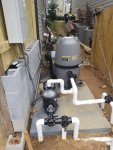Edit by Jim R.
Our pool builder left us high and dry and I am hoping there are some good people out there who can help me self-perform what I can to get the pool working. We are working on getting someone to help with the pavers, retaining walls and the outdoor kitchen areas but I am taking on the plumbing, control systems, sprinkler and other non-construction type items. Overall, we are told we have another $35,000 of work left in the end.
With all that said, the reason for this topic is I am hoping someone who is a Jandy expert, or just a pool professional who knows the plumbing can double check my diagram to see if am plumbing the order of things correctly. I mounted the Jandy Aqualink RS, got enough programming to get the ePump working and keep the pool clean (since it's filled) while we work on the rest. Because the cold is here, I am trying to see if I can get the rest of the plumbing done this week before it gets increasing difficult. Would someone mind checking the attached diagram to let me know if I have the order correct before I bring the rest of the pipes up from the ground in the proper spots? We have a dedicated cleaner return line, 2 LED deck jets (shared 1.5" pipe) and a spa overflow-type setup. I am not sure if I have the JVA and pipe positions correct. I want to be sure, because this will be very hard to change after plumbed. Your help and time are very much appreciated. We are mentally exhausted from this already, with almost 10 months of aggravation and we have no end in sight any time soon. Your help here, goes a long way.
PS - If anyone is in the Woodstock, GA area who also knows plumbing, Jandy, and pools in general we would love to talk with you. We still have to get other accessories mounted, like the spa light, the cleaner port/bulkhead installed, and the water features installed (2 deck jets). We could use an expert for a few days around here
View attachment 88437
 View attachment 88436
View attachment 88436
Our pool builder left us high and dry and I am hoping there are some good people out there who can help me self-perform what I can to get the pool working. We are working on getting someone to help with the pavers, retaining walls and the outdoor kitchen areas but I am taking on the plumbing, control systems, sprinkler and other non-construction type items. Overall, we are told we have another $35,000 of work left in the end.
With all that said, the reason for this topic is I am hoping someone who is a Jandy expert, or just a pool professional who knows the plumbing can double check my diagram to see if am plumbing the order of things correctly. I mounted the Jandy Aqualink RS, got enough programming to get the ePump working and keep the pool clean (since it's filled) while we work on the rest. Because the cold is here, I am trying to see if I can get the rest of the plumbing done this week before it gets increasing difficult. Would someone mind checking the attached diagram to let me know if I have the order correct before I bring the rest of the pipes up from the ground in the proper spots? We have a dedicated cleaner return line, 2 LED deck jets (shared 1.5" pipe) and a spa overflow-type setup. I am not sure if I have the JVA and pipe positions correct. I want to be sure, because this will be very hard to change after plumbed. Your help and time are very much appreciated. We are mentally exhausted from this already, with almost 10 months of aggravation and we have no end in sight any time soon. Your help here, goes a long way.
PS - If anyone is in the Woodstock, GA area who also knows plumbing, Jandy, and pools in general we would love to talk with you. We still have to get other accessories mounted, like the spa light, the cleaner port/bulkhead installed, and the water features installed (2 deck jets). We could use an expert for a few days around here
View attachment 88437

 View attachment 88436
View attachment 88436


